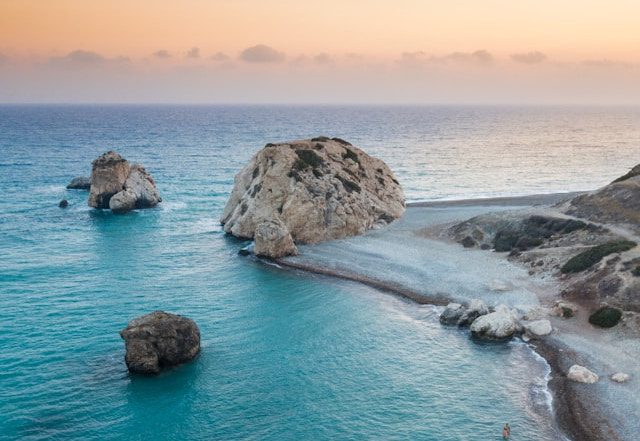This month our edition is dedicated to the Circle’s trip to Cyprus and we hand over to members to report on their highlights while exploring this Mediterranean wine island in February 2024.
Christine Austin sets the scene with the first visit of the trip, sharing intriguing nuggets of information on the Cyprus wine culture and history (did you know phylloxera never arrived to the island? You will by the end of the report!)
Jolanta Smiciene shares the fascinating story of Zambartas and their dedication to indigenous Cypriot grape varieties, which seems like a very worthy mission, indeed, on reading tasting notes later in the report.
Rosemary George MW shares her takeaways from Tsiakkis winery in the Troodos Mountains, with some of Europe’s highest-altitude vineyards. Her report shares the refreshingly frank words of owner Orestis Tsiakkas, as well as some fascinating historical context (who knew Cyprus sold so much wine to the UK!)
Michael Pinkus shares his experiences at Kyperounda winery, which included the group taking a voyage to their highest-altitude, and rather chilly, vineyard at 1,480 m.a.s.l.!
Paul White reports on the group’s visit to the modernist winery of Vlassides, which is increasingly championing native varieties over its French implants, partly in response to climate change.
By candlelight, Ann Samuelsen tastes wines from the 200-year-old Argyrides winery in Koumandraria, and she enthuses about their elegance and maturity in her report.
The following day, the group did some sightseeing — exploring the 13th-century Kolossi Castle, as Vivienne Franks reports; and the Cyprus Wine Museum, as Ann shares. Ann’s report on the Museum visit also digs deeper into the history of Cypriot wine, which is no less than 6,000 years long!
Janet Z. Wang gives us a double whammy with her reports on visiting two wineries in Laona Akamas and Pretori. At Vasilikon winery, she learns why bush vines work well in this terrain (with some of their vines over 100 years old!) While at Nelion Winery, she learns about some of the key marketing terms and trends in Cypriot wine today.
From the last day of the trip, Christos Ioannou marvels at the new Marathasa winery — which opened its doors barely a year ago. Meanwhile, Markus Hungerbühler shares detailed information and impressions about Cyprus’ ‘Wine of Kings’, Commandaria.
This report was compiled and edited by Robert Smyth.
DAY 1
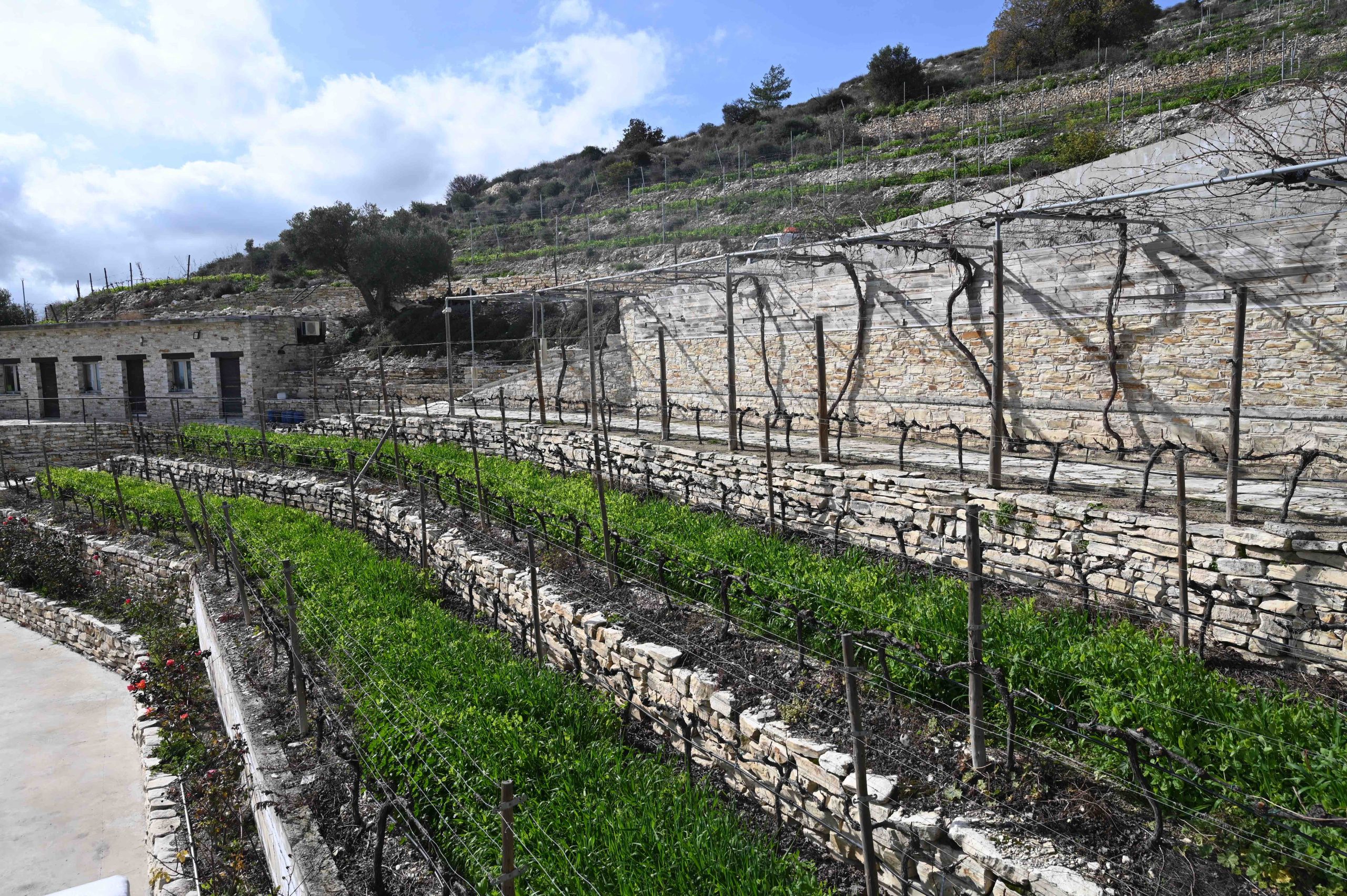
Christine Austin kicks off the Cyprus sojourn at the Dafermou Winery.
This was the first visit of the Cyprus trip, so it was good to leave the bustle of Limassol, head a few kilometres east, in the direction of Larnaca, and then up into the hills to Lefkara. There, built into the hillside is the long, low, modern concrete Dafermou winery, where owner Savvas Fakoukakis gave us a warm welcome. Behind him and his big smile were several sparkling chandeliers, not the first that I have seen in a winery, but still they were unusual. The reason for chandeliers was not so much that Savvas is into elaborate interior design, more that they reflect the two sides of his business.
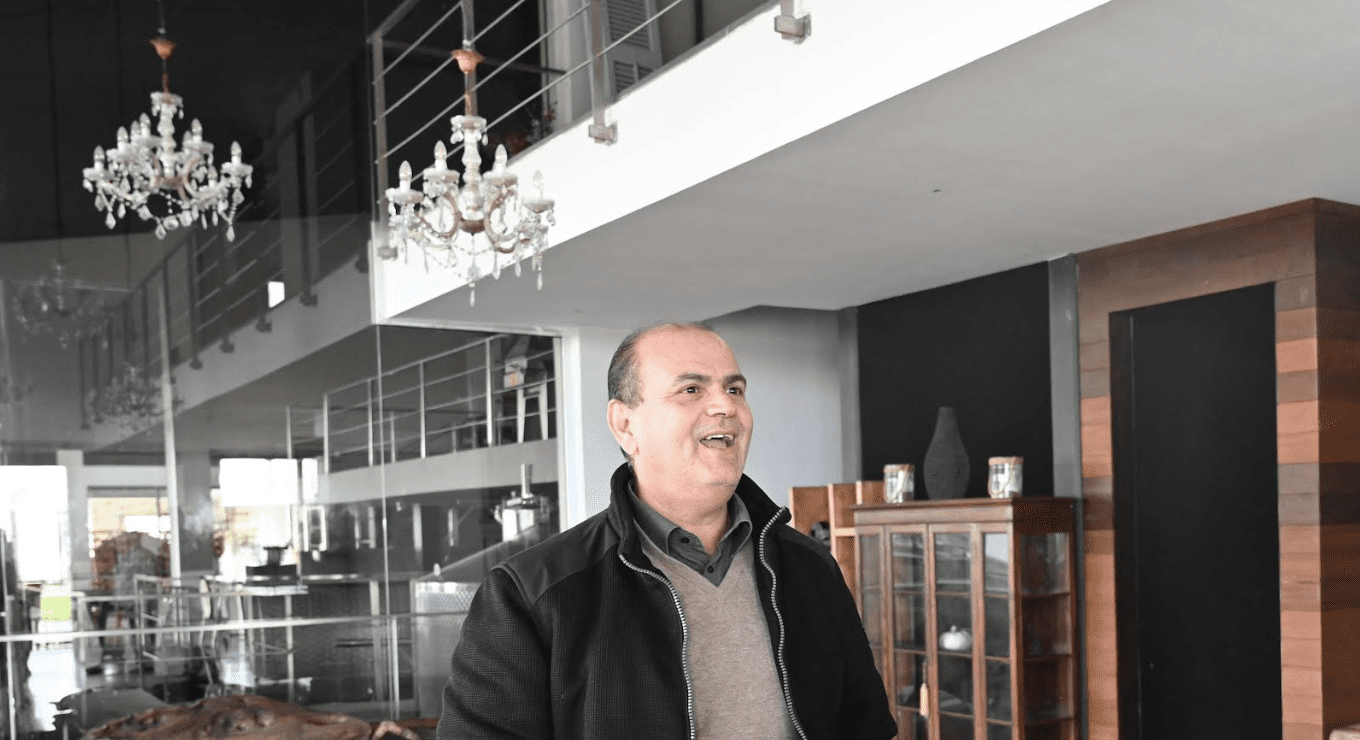
This well-equipped winery was designed, not just to make wine, but to also host weddings, conferences and events. Built in 2012 with just a few vines planted around the estate, there is the capacity to host 500 people for a sit-down reception. And that is where the money to invest in the wine business has come from.
Vineyards are difficult to buy and are very expensive in Cyprus, where a small plot can be divided amongst dozens, maybe hundreds of distant family members. Savvas has now managed to find and invest in 10 hectares of vineyard at 1,000 to 1,200 metres altitude, where he grows local indigenous grape varieties, as well as some international varieties.
Savvas is keen to focus on local red grapes in his vineyards. “I first planted Yiannoudi in 2019, and made just 1,000 bottles. This won a gold medal from Decanter,” he said. “I have planted Marethefiko, which has its own problems with pollination, but this is overcome by co-planting with another variety, I usually use Mavro. I also have my own nursery to propagate vines.” Later in the visit, we saw a vineyard worker preparing cuttings for planting, and unlike most vineyards where grafting is a major task, “we just plant the cuttings in the ground, and we get a 95% success rate”. Phylloxera never reached Cyprus, so cultivating and expanding plantings of local grapes is easy, if only the land is available.
The winery is well equipped with all the expected cooling equipment, stainless steel, French and American oak casks and large oak vats. The tasting was excellent.
The Xynisteri wines showed bright lovely fruit, some blended with 30% Sauvignon Blanc, each one showing more depth and minerality as the vines age. The 2018 vintage, part aged in oak and acacia, has complexity showing this variety can develop.
Half a hectare of Assyrtiko, trained on wires and not in the koulouri style because of the difficulty in getting workers, is planted at 800 metres (m) altitude. The 2022 was crunchy with citrus fruit and minerality. The 2017 had aged well. Yiannoudi – from a very young vineyard, is co-planted, with Xynisteri and Morokanella. The 2022 started with chunky, Victoria plum and cherry fruit while the 2021 showed more developed flavours, of rounded fruit with bayleaf and spice notes. “I think that Yiannoudi will be the signature red grape of Cyprus,” said Savvas. So far these wines are not exported but Savvas went to ProWein 2024 to develop his overseas markets.
The future for this winery seems secure. Savvas studied in the UK at Reading University, which led to senior positions in Cyprus wineries, before branching out on his own. His son has studied at Plumpton College and will undoubtedly continue to develop the vineyards and wines. Facilities for agrotourism will be developed in the near future. Watch this space.
…
Jolanta Smiciene zones in on the Zambartas Winery, whose founder Akis Zambartas brought 14 Cypriot indigenous grape varieties back from the brink.
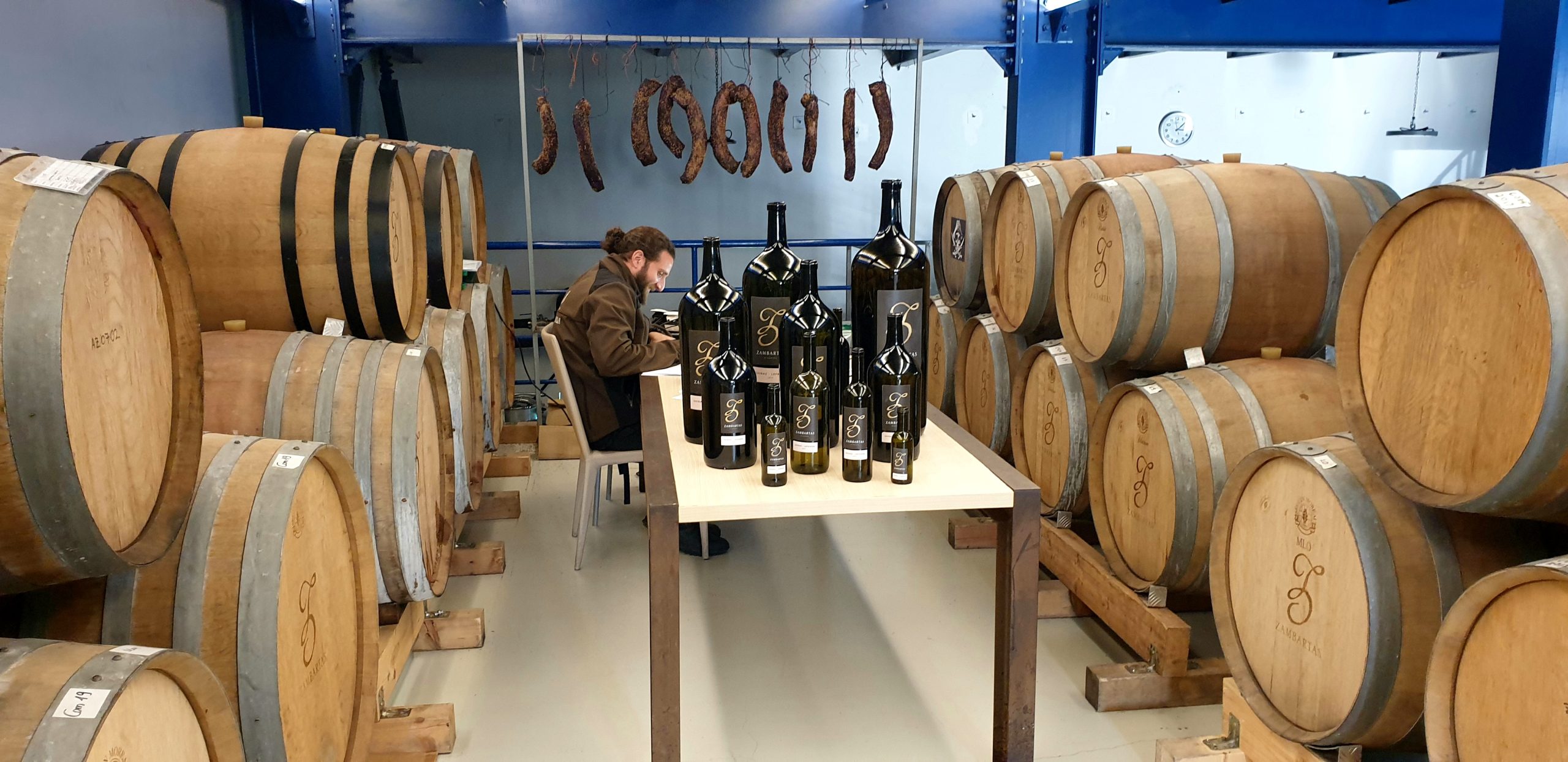
The wine story of the Zambartas family started in 1970, when Akis Zambartas, a young man at that time, went to France to study Chemistry in Lyon, and then Enology in Montpellier. He returned to Cyprus as the first university-educated enologist on the island of Cyprus and started his career at one of its major wineries.
After four years of research, Akis Zambartas identified and recorded 14 lost Cypriot indigenous grape varieties. This achievement would later serve to change the Cypriot wine industry. He made a vital contribution to Cypriot wine history with his project to re-discover Cyprus’ indigenous grape varieties in years of pioneering research and became a leading authority on Cypriot wines for many years.
Five of the 14 varieties hold more interest, because they have the potential to craft elegant and quality wines. These are Lefkada, Maratheftiko, Yiannoudi, Promara and Morokanella. The rest of the discovered varieties require more research in the future.
In 2006, Akis decided to establish his own boutique winery and made wines with the focus on making quality wine from indigenous varieties. His son, Marcos Zambartas, joined his father’s winery two years later, when he returned from Australia with a Masters degree in Winemaking after studies at the University of Adelaide.
Zambartas manages over 13 hectares of organic vineyard (owns eight hectares of vineyards and rents another 12 hectares). The vineyards are of different ages and are concentrated mostly in the areas of Mandria village and Agios Nikoloas, between 800-1,000 m of altitude. As most of vineyards are situated in areas close to non- cultivated nature, the Zambartas family profits from the rich biodiversity around the vineyard. They restore the traditional stone walls that separate terraces, which does not only contribute to the beauty of the fields but is also provides shelter for much needed larger reptiles and insects.
The winery’s production is 120,000 bottles a year. Marcos Zambartas currently runs the winery together with his wife, Marleen. She is responsible for the winery’s online activities and export markets. The Zambartas winery is located in Agios Amvrosios, a village in the Limassol area, where we had meeting and tasting together with Marcos. Our group was warmly welcomed by the charismatic Marcos and also his lovely wife Marleen. Marcos gave us a quick tour of the winery short presentation of Cypriot wines.
According to Marcus, 90% of modern vineyards in Cyprus were planted just 20 years ago. Before joining the European Union, Cyprus was one of the biggest bulk wine exporting country in the world. According to EU requirements, all old Cypriot vineyards were uprooted without any research. However, the EU financed the planting of new vineyards. It was mostly international grape varieties at that time. Indigenous grapes appeared after the efforts of Akis Zambartas and other local grower enthusiasts.
Tasted wines and comments:
Promara 2022
Origin of the grapes: the village of Lasa, Polemi region, south western slopes of Troodos, calcareous soil,12-year-old bush vines. PGI Paphos. Promara is a forgotten white grape variety indigenous to Cyprus, vineyards represent less than 1% of the total vineyard area in Cyprus. The bush wines were planted in 2010 on calcareous soil, at an altitude of 500 m. Pressed juice without too much skin contact. Fermentation under cold temperatures, 50% in stainless steel and 50% in used oak barrels. Sur-lees maturation. Medium-intense aromas of citrus fruit and minerals. Medium-bodied with expressive acidity and a long aftertaste.
Xynisteri 2023
This wine was crafted from low-yielding old Xynisteri vines grown at an altitude of 850 m in the Krasochoria region. Volcanic soil. Fermented in stainless steel. Fresh and distinctively aromatic. Citrus and stone fruits dominate the aromas. It has crisp acidity and a long aftertaste.
Single vineyard Xynisteri 2016
Planted in 1988. Organic viticulture, ambient yeast, 100% oak-fermented in 450-litre barrels with acacia heads for 6–7 months. More depth of colour. Aromas of white peach, exotic fruits and a hint of white flowers. Well balanced, with supple acidity and fine oak buttery notes. Creamy texture.
Single vineyard Xynisteri 2022
Led by citrus fruit, stony aromas. Vibrant acidity, long aftertaste. A youthful but solid wine with big potential. Annual production of 3,000 bottles.
Margelina Single Vineyard 2019 PGI Lemesos
An 80% Mavro field blend. From a 100-year-old vineyard bought in 2015 from the Cypriot eBay equivalent. Marcos kept the old vines despite advice to pull them out. Spontaneous fermentation in stainless steel. Matured in 400-litre used barrels for six months. Very expressive, aromatic, fruity. Aromas of red fruit, strawberry, cherry. Deep acidity, long aftertaste. Food-friendly.
Margelina Single Vineyard 2022 PGI Lemesos
Fruity, but still closed on the nose. There’s sweet berry fruit on palate but then firm, slightly astringent tannins, so it needs food.
Maratheftiko 2019
Chalky soils at an altitude of 800 m, bush wines on southern slopes of Troodos. Grape selection by hand on sorting tables, fermentation in temperature-controlled stainless steal tanks, maceration three weeks post fermentation, 10 months of ageing in large, used oak barrels. The scent of violets, red fruits, cherries and spices. Rich and round, with soft tannins. Big potential.
Melusine Commandaria 2011
Made by the father, Akis Zambartas. The grapes were dried on elevated drying beds, with partial shading, then pressed after two weeks and fermented spontaneously in stainless steel. The wine is then aged for 10 years in used oak barrels before bottling. The wine is a light amber colour, with notes of dried fruits, honey, orange peel and balanced acidity to keep its freshness.
…
DAY 2
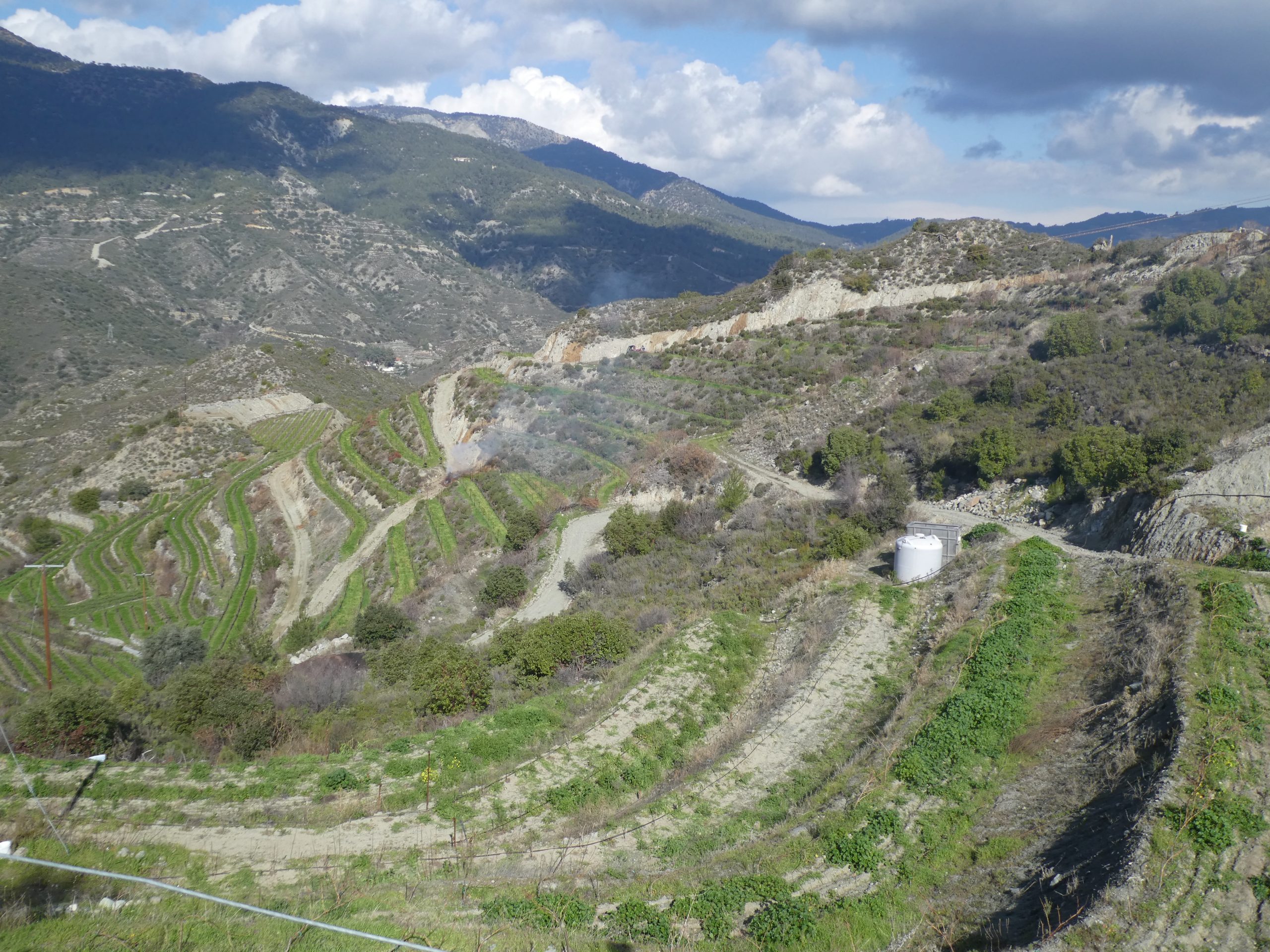
Rosemary George MW gives her takeaways on Tsiakkas Winery, from the heart of the Troodos Mountains.
We were welcomed by Orestis Tsiakkas and his brother, Ektoras. There’s a third brother, Andreas, and also a sister, Eleni, who are also involved in the family business, which was set up by their father. Orestis said his father manages them but does not get involved in the winemaking or tasting. They are situated in the heart of the Troodos Mountains, in the PDO of Pitsilia, which has some of the highest altitude vineyards in Europe, at over 1,000 metres.
Orestis gave us a nicely opinionated history of the recent developments in the Cypriot wine industry. “We have no phylloxera, because we are lucky, not because we are smart”. Quarantine is therefore very strict, and you cannot bring in any rootstock. In the 1970s, a lot of the indigenous vineyards were pulled up “because it was thought they didn’t make good wine. The real problem was that we didn’t know how to make good quality”, so Cabernet Sauvignon and Chardonnay were introduced to the island. Tsiakkas even made Riesling, because their father liked it, but “it was a disgrace. And no Gewurztraminer, thank God. You need to understand your capabilities”. These days, Sauvignon has been replaced by Xynisteri, and they are looking at white Promara, as well as Yiannoudi and Vamvakada, which is also called Marathaftiko, for reds.
Cyprus used to export a lot and indeed was the third importer into the UK after France and Spain (thanks to sherry) in 1978. But since 1988, the Cyprus wine industry has been reshaped, with the development of small family wineries. Tsiakkas is one of the first. And then came the big shift from quantity to quality over the last ten to 15 years.
They began in 1988, first by buying grapes, and then small plots of land, so they now have 25 hectares. The furthest is 40 minutes away and the highest at 1,480 m. The land is very segmented, and problematic to buy. A small plot of not even one hectare could be owned by as many as 50 people.
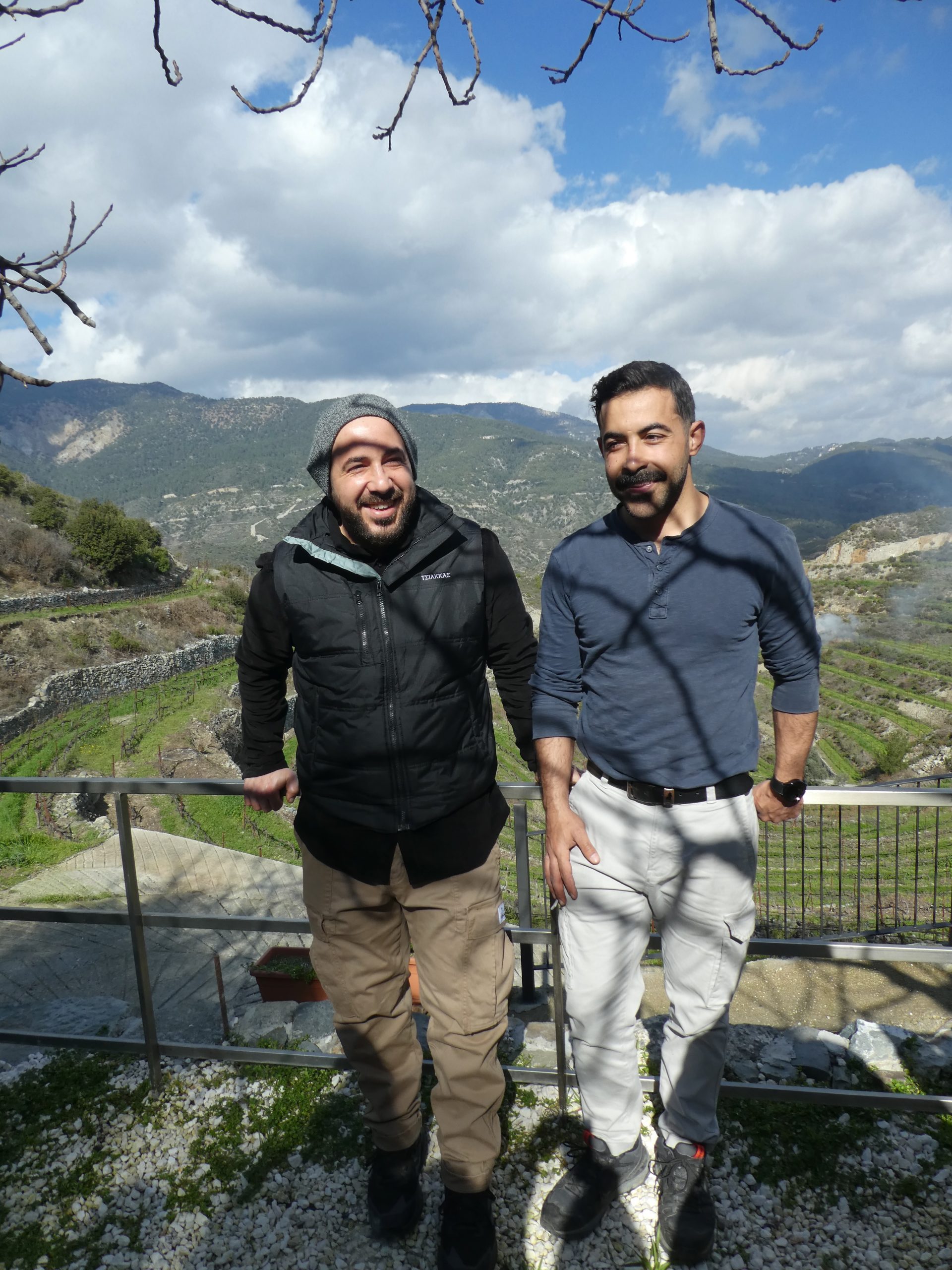
We were standing looking over vineyard land and old terraces, with a view of Mount Olympus, which brought us on to geology. When the African and Eurasian tectonic plates crashed some 92 million years ago, the Troodos Mountains, eight kilometres under the sea, were thrown up into the air, so this is where geologists come to study the ocean floor as it was 92 million years ago. The soil is poor, sandy and volcanic, without a lot of nutrients, so they need to plant green manure, to remedy the deficiencies.
There was a huge fire in the area 15 years ago, which destroyed everything, including the old winery, but also revealed old stone walls that were 400 years old. The vineyards had been abandoned when the Ottomans came to Cyprus, and wine production only resumed when the British arrived in 1878.
The cellar contained the usual tanks and barrels, mostly French, with some American oak. Orestis had also tried an acacia barrel but didn’t like it; he threw the contents away. He had also had a wooden egg, but it had exploded, and he is now intending to try amphora for Yiannoudi. The tasting that followed concentrated on the indigenous varieties, finishing with some delicious Commandaria, and leaving us in no doubt that Tsiakkas is an excellent player of the new wave of Cypriot winemaking.
…
Michael Pinkus picks up the thread at the Kyperounda Winery.
The Kyperounda winery takes its name from one of the villages of Pitsilla, where it is located, 50 km from Limassol, 75 km from Nicosia, and it boasts some of the highest vineyards in Europe at 1,200 m. Kyperounda was started in the late 1990s (1998 to be exact), by a group of local winemakers, with their first vintage being 2002. Today, 70% of the investment comes from one family.
We were greeted by Minas Mina, general manager and winemaker – Greek trained with a masters from Glasgow in fermentation, received in 1999. He explains that we are standing at what was once the deepest part of the sea. When pressed about how high the vineyards are, we pile into several cars and drive up to 1,480 m where their highest vines are located – five minutes from the winery building and up some winding hills. They farm 20 hectares, but also buy grapes from surrounding vineyards. They even have a contract with the vineyard at the highest elevation in Cyprus (1,535 m), just over the hill from where we are standing; Minas points it out as nonchalantly as one would a passing car.
As the lone Canadian in the group, and the only one daring enough to wear shorts every day (the weather promised to be 19 to 20 degrees each day), I will now fully admit to being a bit chilly (the only time) at this elevation – while down by the beach it might have been sunny and warm, up here at 1,480 m the temperature was a crisp 7°c – thankfully it was a brief visit. Minas also shows us the irrigation system they must use up here, the weather station and the sage and other plants they mix in to prevent erosion.
The mineral rich soils and high elevation are good for grapes like Chardonnay, Sauvignon Blanc, Syrah and even Cabernet Sauvignon, as well as some of the indigenous varieties. Minas also added that the south-facing slopes are good for the red varieties, while northeast-facing are home to the white varieties.
The harvest for these high elevation vines comes mid-October and runs into November. Incidentally, they see little to no rain through September and October and climate change has meant less snowfall in winter, and more potential for storms at harvest time – Minas claims they have not seen significant temperature change though.
Another interesting note, is how reticent Cyprus is to screwcaps, and this was the second winery to react negatively to the prospect of putting their wines under this closure.
I’m sure everyone has mentioned that Cyprus is also phylloxera free, which seems to be a source of pride for them; with each winery principal we meet having their own take on a reason why the blight did not take here. Minas was no different, citing the isolationist nature of the island and unfavourable conditions for the bug to exist.
The flagship wine at Kyperounda is called Petritis. It’s 100% Xinesteri and makes up 50% of their production.
…
DAY 3
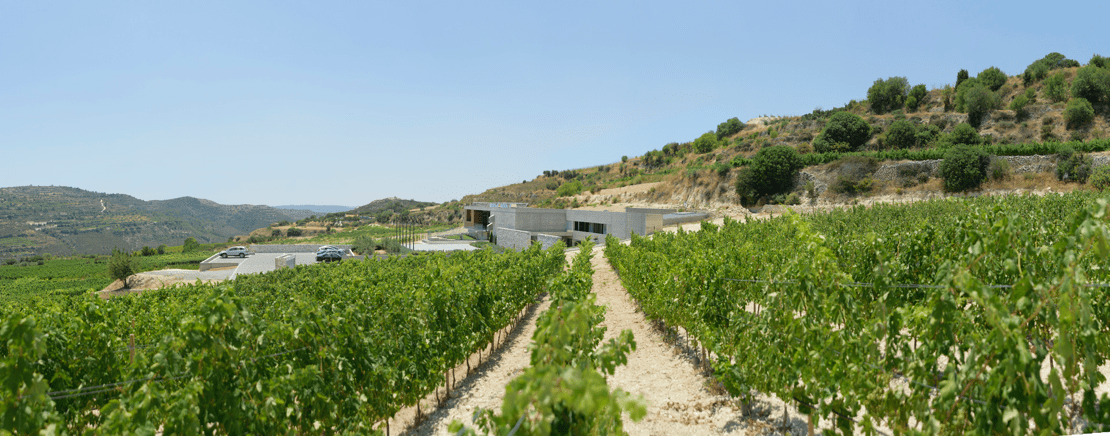
Paul White is welcomed at Vlassides, a winery which has come full circle.
Like Cyprus’ wine history, Sophocles Vlassides has come full circle. A third generation winemaker, he established a vineyard and winery near the village of Kilani, where his grandfather once made wine with local grape varieties for local consumption, and where his father, a winemaker at ETKO, Cyprus’s large industrial winery, replanted his vineyard with French grapes in 1968.
Ignoring further French influence, Sophocles completed a postgraduate degree at California’s UC Davis in 1998 and brought back this ‘New World’ knowledge to establish his own vineyards in 2003. Nudging 25 hectares, these contain both international and indigenous varieties, grown between 700-1,100 m in a mix of sand, loam and limestone soils and on modern, irrigated trellis systems.
The ‘modernist’ glass and concrete box winery Sophocles built could have been dropped in from Napa, Barossa or Tupungato. Based on gravity-fed stainless steel and French oak barrels, this impressive winery was completed in 2012 and represented Cyprus in the 2015 Mies Van der Rohe Awards.
What separates the Old World from the New, however, is the wall of 400+ year old terraces in the hills opposite and above, where grapes have grown for millennia. Returning to those roots, Sophocles is part of a newly-formed, 14-strong growers association called WINECORE (WINEries’ of Cyprus Own Rooted Evolution), which is focused on promoting and elevating Cyprus’s unique local varieties.
Vlassides’ portfolio now reflects a shift away from French grapes toward autochthonous varieties. With Cabernet Sauvignons at 15% alcohol and Merlots nudging 16%, a combination of cultural awareness and climate change is pushing these imported varieties off the landscape.
The best of the foreign interlopers is found in Vlassides Eddial 2019, a finely-bubbled, lemony tart 60/40% Chardonnay-Sauvignon traditional method blend, on lees for three years. Another remnant is the 15% dollop of Sauvignon added to Grifos 2 2023 (12.5%), giving floral lift and acidity to Xynisteri’s melon-infused, fleshy, highly polished texture.
But the ongoing trend is to treat local varieties with serious intent and in their own right. The leading local white is Alatis (meaning wings) 2021, a 100% Xynisteri made from old bush vines and fermented in large wooden tanks. Minerality delivered through a voluptuous, highly viscous texture with just enough acidity sneaking through. Since 2018, Alatis has steadily evolved away from intrusive French barrique-derived characters towards more fruit purity.
Οroman (meaning Dream to dream) follows a similar stylistic transition. Early versions were a blend of 90% Yiannoudi with a touch of Shiraz to fill in, what Sophocles used to feel was Yiannoudi’s hollowed-out middle. Now seen as something more standalone, between Pinot and Syrah, Shiraz additions to Yiannoudi disappeared after 2022.
Tasting Οroman 2018, 2019 and 2020 side by side offered the opportunity to see Yiannoudi developing at its most expressive. Whilst all shared Yiannoudi’s mix of red and black fruit characters, creamy-smooth continuous textures and finely-managed tannins, overall evolution leaned towards broader florals, finer, lighter textures, and more purity.
Other interesting experimental wines include: A7 Agiorgitiko: B10 2020 Promara; B9 2020 Assyrtiko and Commandaria-styled, sun dried. late harvested B7 2018 Sauvignon.
Tavera review
The lunch at Takis Taverna, located in the narrow streets of the well-preserved medieval mountain village of Vouni, was built around a typical range of mezzes, followed by a lineup of roasted, fried and skewered meats, attentively cooked using top quality local ingredients. The highlight was a pitcher of village-made red wine, produced in traditional clay pot pithari by the waiter’s father. The general reaction of the table of wine journalists was how astoundingly modern, fresh, clean and fruity it was.
…
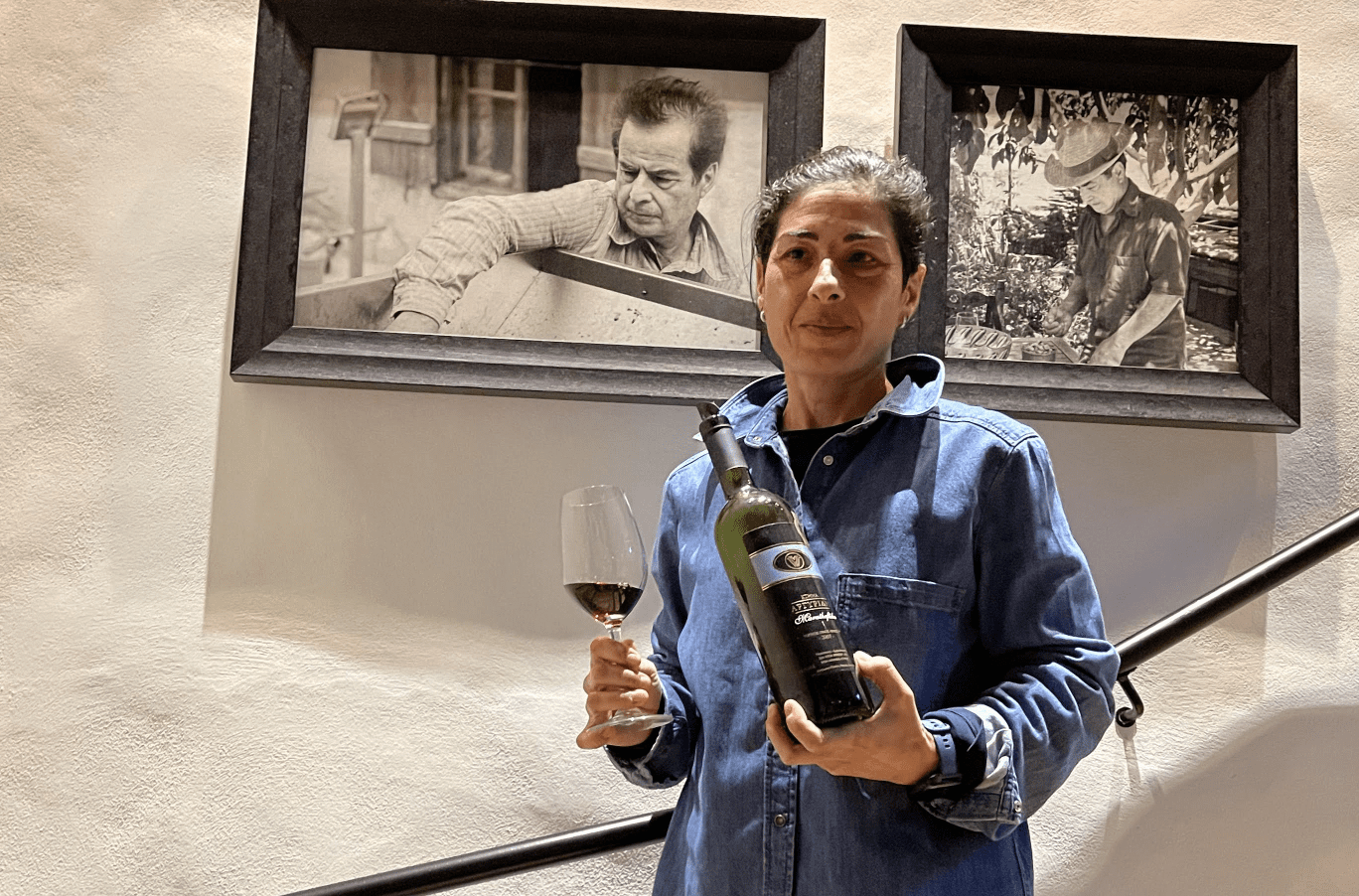
Ann Samuelsen tastes some awesome wines by candlelight at the Argyrides winery.
Saturday was all about the Koumandaria region, up against the mountains. The first visit was to Koilani for the Vlassides winery and then a lovely lunch at Takis Taverna in the colourful village Vouni, where we also had a nice stroll around. Then, it was time to drive towards Vasa Koilaniou for a visit to the charming Argyrides winery in the Laona Krasochoria viticultural area.
We were very warmly greeted by the modest Rebecca Argyrides and given a tour of their 200-year-old winery. Tradition meets innovation in this ancestral home, which has been restored and expanded and modernized to become a modern boutique winery. The Argyrides winery is a small family-owned establishment with a great team of dedicated women – Rebecca, sister Andriana and their mother Irene. However, the Argyrides winery was founded in 1996 by the father and husband Charalambos.
The first vintage from Argyrides was a Mourvedre red wine named Saint Timon from 50-year-old vines. Charalambos expanded the winemaking enterprise, investing in more land and planted new grape varieties, such as Cabernet Sauvignon, Maratheftiko, Merlot and Chardonnay. From 2005 to 2010, they bought sufficient land to only grow own grapes and additional varieties, such as Viogner and Xynisteri.
Argyrides vineyards now amount to eight hectares at a high altitude of 900-1,100 m (3,000 – 3,200 feet). Some of their highest regarded vineyards are Melantzi for high- end Chardonnay; Laona for the temperamental local Maratheftiko and Raftiens, with Mourvedre.
After a guided tour with Rebecca, she took us through their beautiful home to greet her mother Irene, before we went over to their cosy tasting room. This afternoon tasting became even more intimate as the electric lighting broke down and we were suddenly surrounded by lots of burning candle lights. In this restful atmosphere Rebecca guided us interestingly through a wine tasting with refined and well-made wines.
The tasting started with two different Viogner white wines. The first, the 2023, had been bottled just a few days before our visit and revealed light, delicate and floral tropic fruit with fresh acidity and a smooth palate. The other, a 2020 Limited Edition, was more perfumed and spiced on the nose, with creamy notes, textured layers and an elegant refreshing finish. The second Viogner was made in stainless steel tank but were finished off in barrique for 6-7 months (3 different coopers, used oak, medium toast) and no malo was done.
Then it was time for the characteristic local variety Maratheftiko. We first got the 2019 vintage, which was structured with inky black fruit and vanilla tones. The 2018 was an elegant food wine with dark cherries and forest floor notes, with some spicy hints. Then Rebecca treated us to the 2016 of the same grape variety and this vintage was the best year for Maratheftiko we were told. A lovely, refined mature red wine with a beautiful tertiary bouquet of tobacco and cedary dark fruit.
Rebecca became even more excited, since we so highly appreciated their well-made wines, that she also picked up the Maratheftiko 2007 vintage from her private wine cellar. This was a very special moment for Rebecca and us, since it was her father Charalambos that had made this wine, which is a harmonic and nicely matured red wine with earthy forest berries and meaty notes on the nose and finely matured tannins with a super long and elegant aftertaste.
We all thanked Rebecca hugely for this amazing experience, before it was time for an hour bus ride down to our hotel in Limasol.
…
DAY 4
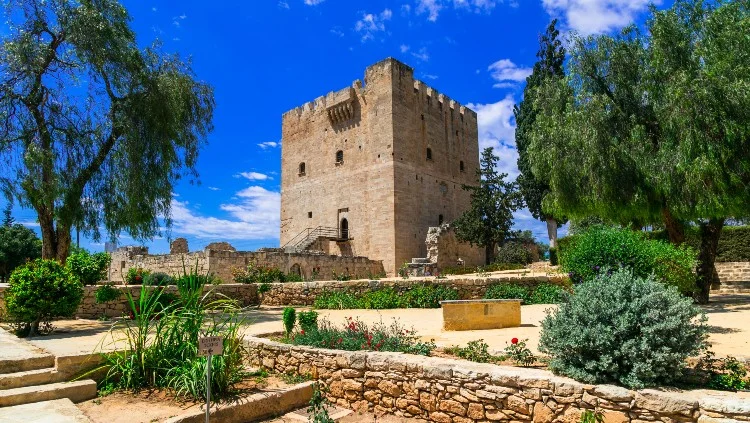
Vivienne Franks goes on a date with history at Kolossi Castle, a former Crusader stronghold.
One of the delights of participating in a CWW Trip is to experience not only the wonderful wines of the region, but to have the opportunity to be a tourist and visit the interesting sites.
One Sunday morning highlight was our visit to the Kolossi Castle, near the village of Kolossi, about nine miles west of Limassol. This former Crusader stronghold was originally built in the 13th Century and rebuilt in the 15th Century, by the Commander of the Knights Templar, Louis de Magnac.
By the end of the century, the Kingdom of Cyprus had been lost to the Venetians, who used the area around the castle for sugar plant production. The Ottomans subsequently defeated the Venetians and destroyed the castle. All that is left is a three storey Keep and the Bailey. The remaining legacy is the famous Cypriot dessert wine, Commandaria, named after the Knights Hospitaliers. This wine is believed to be one of the world’s oldest produced wines.
According to legend, Commandaria was the wine of choice at the wedding of King Richard the Lionheart to Berengaria of Navarre at Kolossi Castle. Our tour guide Annita Agathokleous has an extraordinary knowledge of the history of Cyprus and is a brilliant speaker. She really brought the history of the Kolossi Castle to life.
…
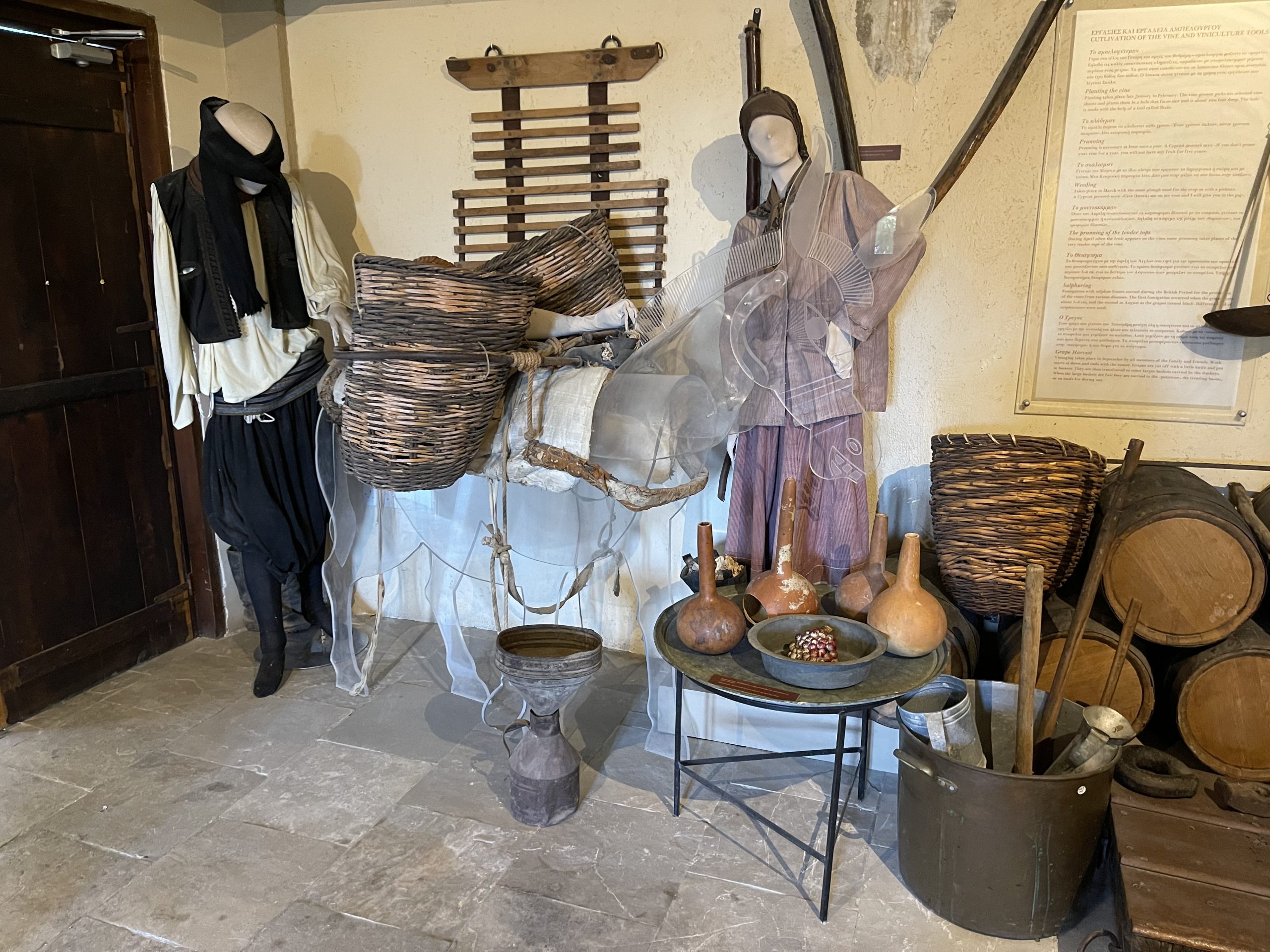
Ann Samuelsen revels in the historical delights of the Cyprus Wine Museum and Aphrodite’s birthplace.
After a short bus ride from the medieval Kolossi Castle, we arrived at the Cyprus wine museum in Erimi Village, which is at the crossroads of the wine routes of Cyprus and has a 5,500-year history of winemaking. This museum is a tribute to an integral part of the history of the island, by the founder Anastasia Guy.
The traditional Cypriot building where the museum is located has been in the family of Anastasia Guy for generations. Earlier the building was an inn, where wine merchants from the wine villages of Lemesos and Paphos used to meet and stay overnight on their way to Lemesos’ main market. It took six years to restore these 150 years old building, before the museum opened in 2004.
The main characteristics of Cyprus’ vineyards in the 1960s was a dominance of the two indigenous winemaking grapes, Mavro and Xynisteri. Of the total area of cultivation, these two grapes covered 79% and 19%. The other winemaking grapes of that time were Ofthalmo, Lefkada, Maratheftiko, Vlouriko and Yiannoudi as red grapes. And Malaga, Muscat Alexandra, Spourtiko, Kanella, Morokanella and Promara as white grapes.
The sweet wine Commandaria has an almost 6,000-year-old history. It was made in amphoras as was also done in Armenia and Egypt. It was made with the grapes Mavro and Xinisteri, which varied in percentages, according to where on the island it was made. In vineyards at higher altitudes, Xinisteri dominated, while in lower laying vineyards Mavro was the main variety. These grapes were dried in the sun on the roofs of houses before making the wine in amphorae. At this time, Cyprus’ flagship wine Commandaria was enjoyed in different kinds of cups made from clay.
Later in the 1970s, the government started to import several winemaking grape varieties from wine producing countries in Europe, which included Carignan Noir, Grenache Noir, Palomino and others.
From the 1990s and onwards, Cyprus became more focused on better quality grapes from low-yielding varieties and began planting the red grapes of Cabernet Sauvignon, Shiraz and Merlot Noir and the white grapes Chardonnay, Riesling, Sauvignon Blanc and Semillon.
After an hour at the wine museum, it was time for the bus again and next on the program was a short stop at Petra tou Romiou for photos. According to the legend, the ancient Greek Goddess of Love and Beauty, Aphrodite, was born of the sea foam here. Her birthplace is in the middle of three rocks in the sea just off the mainland. The old history tells that if you want to retain beauty, you have to swim seven times around this place at full moon.
Aphrodite had several different names around the island, and this is told to come from an old story that Aphrodite had several boyfriends around the island, because her husband was not a nice man.
…
DAY 5
Janet Z. Wang takes us to two wineries: Vasilikon and Nelion.
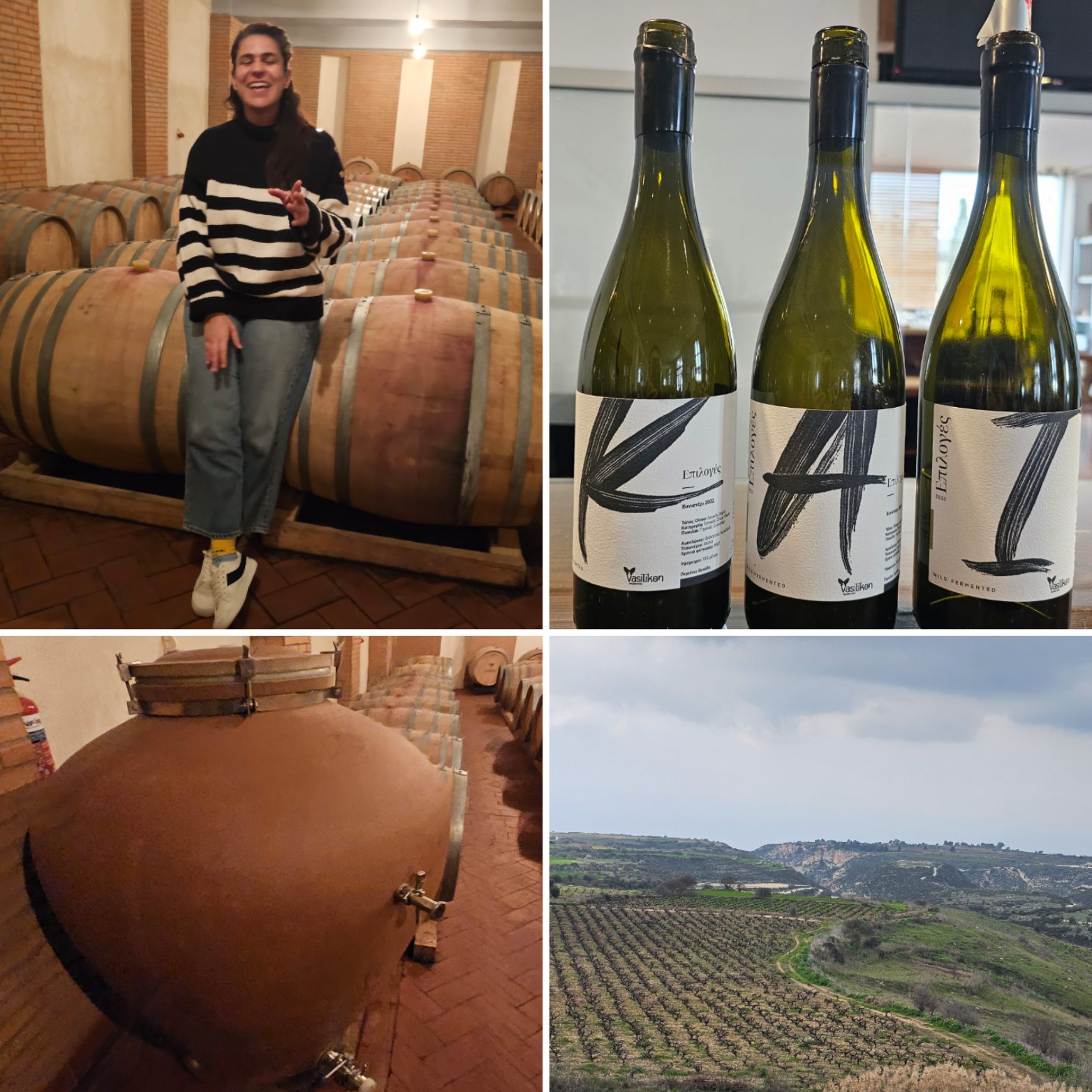
Vasilikon Winery
Today’s winery visit took us further north and west, into the Laona Akamas region and the village of Kathikas. At the entrance to Vasilikon, we were greeted by winemaker Afroditi Constanti, who told us that this is one of the first family owned wineries in the region, founded in 1993 by brothers Heracles, Georgios and Yiannis Kyriakides. She then led us through the spacious reception area, out onto an enormous terrace, overlooking a panoramic view of the valleys and vineyards of Akamas. We were joined by Yiannis, and Georgios also popped by to say a quick hello.
Yiannis told us that their father used to be a local farmer selling grapes to large industrial wineries, and the brothers were driven to set up the winery by their family ties to this land, which produced wonderful, yet undervalued and poorly understood, indigenous grapes. The region has been known to produce excellent Xynisteri, along with other native varieties, thanks to a terroir that is influenced by its closeness to the sea and altitudes ranging between 600-700 m. The soil here is mainly lime with some (volcanic) loamy-gypsum. The valley also creates a mist, thus the grapes can benefit from coolness and gentle moisture in summer. This is a particularly welcome respite in August.
Vasilikon has some of the oldest vines in the area, averaging around 65 years and up to 104 years. They have kept the tradition of working with bush vines, which is common in the region. Yiannis told us that they trialled trellises on a small scale, but it was clear that bush vines are better suited to the conditions of Cyprus, “Because the goblet shape of the bush vines shield the grapes from the intense sun, instead of exposing them on a line,” said Yiannis, with just the slightest hint of a smirk to his Northern European and Canadian visitors.
“We are also very lucky not to have had phylloxera in Cyprus,” added Afroditi. “So we have these very old vines, and the tradition of continuing to work with original rootstocks and bush vines. People from other regions are amazed to see us plant cuttings directly into the soil. We usually plant two months after we make the cuttings. But on the other hand, everything is done manually in the vineyard, which is the norm in Cyprus.”
Afroditi then gave us a quick tour of the winery and cellar. We learned that the harvest period here stretches from the beginning of August until the end of October. “I could not recommend it to anyone, it is so long and exhausting!” The ‘international’ varieties are harvested first, starting with Sauvignon Blanc, then Syrah, followed by Cabernet Sauvignon, and then the native varieties come in from September onwards.
By now, it is amply clear to us that wineries such as Vasilikon have their hearts in reviving indigenous grape varieties, however, it is the internationally known varieties that provide the bulk of their income, as locals and tourists alike still demand wines from the more familiar varieties, for now.
We were eager to taste the wines, and were treated to a flight of nine wines all made from indigenous single varietals. Starting with a refreshing, uncomplicated Xynisteri (2022, PDO Laona Akama), simply made in stainless steel with cold maceration (<1 day) and low temperature fermentation. It had brisk acidity, distinct salinity and a long salivating finish. A great start!
The three wines that followed were certainly the highlight of the tasting. We were poured three further Xynisteris, collectively called ‘Epiloges (Selections) – K, A, I’, – a trilogy of wines from three neighbouring villages of Kathikas, Arodes and Inia, respectively. This collection epitomises Vasilikon’s love and deep knowledge of the grape. It is the perfect way to showcase the expressiveness of Xynisteri through an exploration of three distinctive vineyard plots, and with vines of different levels of maturity. The winemaking for all three was essentially the same, with vinification in separate stainless steel tanks: spontaneous fermentation followed by lees ageing in tanks for eight months, all from the 2022 vintage, released just a month ago.
Kathikas: planted in 1967; calcareous soil with 15% clay; altitude 700 m; west orientation. The wine displayed ripe citrus aromas, and a round and gentle mouthfeel.
Arodes: planted in 1920; clay-limestone soil; altitude 700 m; east orientation.
We were tasting something very special here, from vines of over 100 years old. The fruits were plush and juicy – fleshy white peach, honey-dew melon, passion fruit… The wine also showed depth with layers of fruits giving way to herbal notes. It was also weightier and more substantial, with an elegant, lingering and tapered finish.
Inia: planted in 2010; calcific-limestone soil; altitude 700 m; east orientation.
This wine displayed more floral and botanical characters. There was also a lovely flinty, chalky dimension to it. Vivid acidity gave a mouthwatering and long finish.
Following the trilogy, we were poured another Xynisteri (2022, single vineyard from Kathikas), called ‘Vasilika’. Half of this wine spent half of its fermentation process in oak barrels and was left on the lees in the barrels for a further three months. This wine showed us the subtle oak effect on Xynisteri, which displayed a creamier, mellower profile.
Next up, we tasted a brand new white variety called Vasilissa (2022, Kathikas), known as the ‘queen of the vineyard’, because of its beauty with vividly green leaves and striking golden grapes. This wine was particularly aromatic and perfumed. Afroditi told us that traditionally many vineyards had miscellaneous varieties that were planted together, and Vasilissa was one such grape, noted for its aromatics and was usually sold as table grape or as a blending grape. Yiannis added proudly, “I’m sure we were the first to plant and treat it as a single varietal. We now have 2.5 hectares of it.”
Then onto the reds. We were poured two Lefkadas (PGI Paphos), vintage 2018 followed by 2015. The origin of Lefkada is somewhat obscure. One saying is that it originated from the Greek island of Lefkada, but this is not substantiated by DNA testing. It is listed as indigenous to Cyprus because it appears to have distinctive leaves and fruits not found elsewhere. Afroditi explained that Lefkada makes vivid, tannic and bold wines and is therefore best treated with gentle extraction. “For me, it is the wine that shows you Cyprus. It has different aromatic styles to other red grape varieties. Instead of berries you get typical Cypriot botanicals like oregano and thyme, and it reminds me of the mountains here.”
Last but not least, we tasted Maratheftiko (PGI Paphos), vintage 2019 followed by 2014. By now, we have tasted a range of Maratheftikos and learned about the variety’s ‘tricky’ aspects. Afroditi added that it is tricky also because the stems can still be unripe after harvest and therefore the grapes must be de-stemmed scrupulously to avoid undesirable greeness. It is also a grape that takes on the effect of oak easily and therefore needs careful and sparing use of oak. Afroditi admitted that the 2014 vintage was their first with this variety, and they didn’t quite get the use of oak right. Indeed, subsequent vintages were made with larger, older barrels, and the 2018 as a comparison showed more pureness and freshness. “We may try it in amphora in the future.” I would love to come back for that, and everything else they make!
Nelion Winery
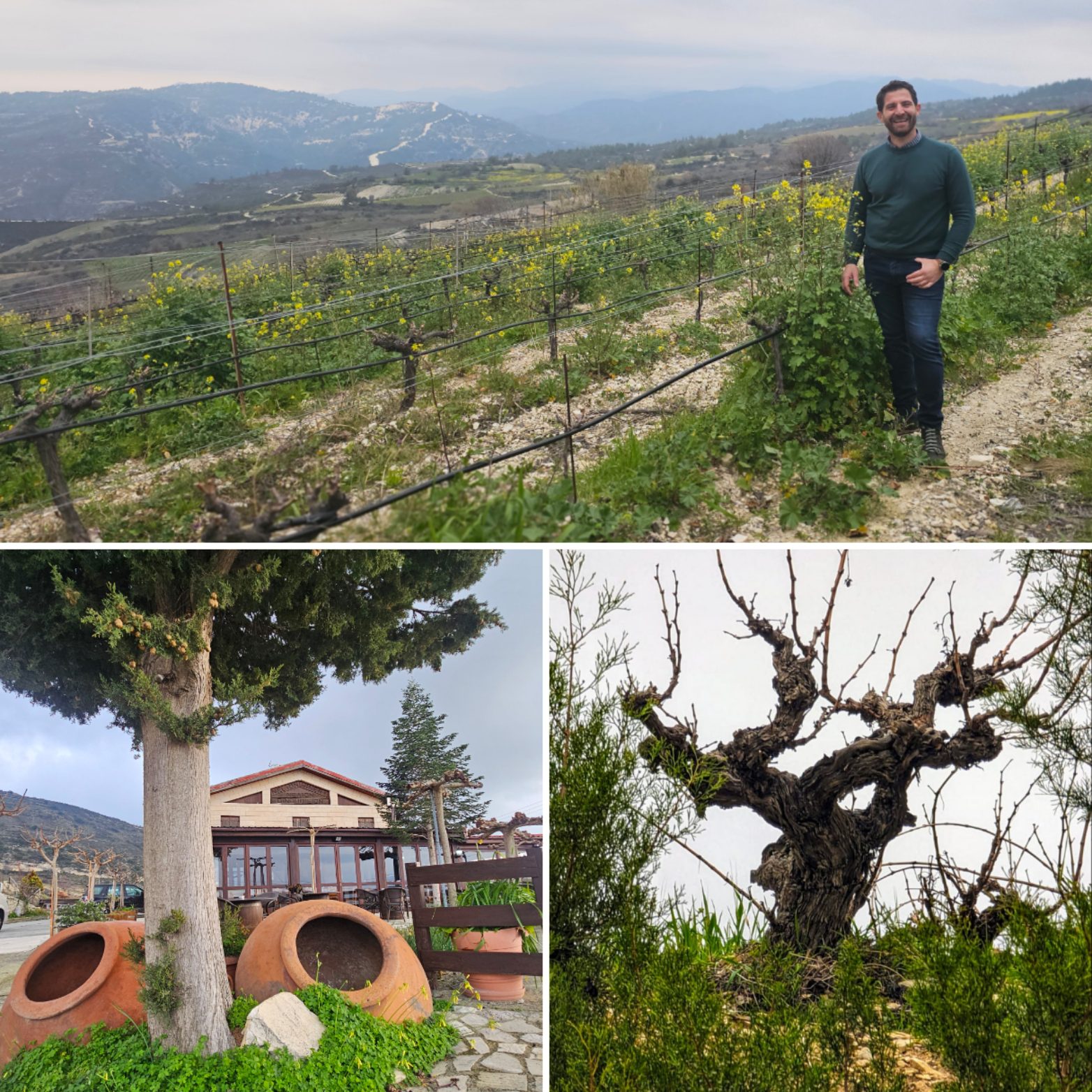
Winding through beautiful mountainous roads along the popular Paphos-Troodos route, we reached the outskirts of Pretori, at Nelion Winery, just before the sun had decided to pack up and give way to the moody clouds which shifted and swelled at this high altitude, atop rolling hills that stretched as far as the eye can see. Nine self-appointed winery cats greeted and vetted us, before general manager and oenologist Marinos Ioannou emerged to take us for a quick tour of the vineyard plot, just across the road from the winery, set against the picture-perfect Diarizos Valley.
“The winery was built in 1996, by my parents. My father is from the local village of Pretori. This village was known as ‘raisin village’. It was famous for producing raisins, because the weather is particularly dry and hot here, even for Cyprus,” Marinos explained. “But, because the valley extends up to the Troodos mountains, in the summer, at night, we get lovely cool breezes, and the diurnal temperature is great. In summer, we may have 32-35°C during the day, and 17-18°C at night. Near the Diarizos River at the bottom of the valley the temperature could be lower still, by another 4°C. The soil is mostly limestone, chalky-marl, with some volcanic. Our vineyards range between 500-900 m in altitude, and that is what we want to explore and showcase in our wines, from single varietal vineyards in the various plots we have.”
Nelion currently owns 6 hectares of vineyards, and managed to produce 35,000 bottles (up from 25,000 previously) in the latest vintage, though the capacity and ambition is to reach 60,000 bottles (and start buying some grapes locally). There are three sites for Xynisteri, four for Maratheftiko, two for Black Muscat and one for Carignan, plus other miscellaneous plots which are still subject to experimenting. Marinos also mentioned that there was a government ‘quarantine vineyard’ for international varieties nearby (an official initiative introduced in the 1950s to prevent the importation of diseases, especially phylloxera), the main varieties there being Carignan, Grenache and Cinsault.
“We have another specific challenge here. The lands around this valley in the next villages mostly belonged to Turkish Cypriots. But after they were moved north from around 1964-74, the lands left behind were given to Greek Cypriots who came from the north, to cultivate, but they cannot be sold. So this can pose challenges for the use of the land and the locations of the vineyards. But we try to work with the challenges here.”
Rather unexpectedly, Marinos then went on to reveal the location for the winery was deliberately chosen to be on a main road! “It’s a commercial decision – we want traffic to the winery!” Marinos explained candidly, while reminding us to watch for traffic as we crossed the road to return to the winery.
Back in the warmth of the tasting room, we were presented with a flight of six wines:
- 2RIZES, Xynisteri 2022
The name is inspired by the confluence of the two river tributaries that flow through the valley. The Xynisteri grapes in this wine come from different plots at different altitudes, vinified differently to bring out the best characteristics of each plot. For example, lower temperature fermentation is used to bring out plots with more citrus driven aromas, and higher temperature fermentation is used to bring out more tropical fruit aromas. After blending, the wine is left on the lees to mature for four to five months, to give the wine more body and structure. There is no wood influence in this wine. This is the winery’s signature Xynisteri – it is fresh, pithy with a mouthwatering finish. The wine is labelled ‘sur lees’, Marinos says that this was a marketing decision, “everyone is doing it in Cyprus, but we were probably the first to spell it out on the label, it is trendy.” Marinos shrugged, “Nowadays, marketing is very important, it’s a reality.”
“The cork of this wine is made of ocean bound plastic. The others are made with sugar cane. This is our way to help the planet.” Marinos said, before adding, “Actually this also helps with marketing.”
- RKAES Xynisteri 2022
The name means ‘old spinster’, a nod to the vineyard area where a monastery once stood. The Xynisteri comes from the lowest altitude vineyard at around 500 m. It is fermented in stainless steel, followed by four months in Acacia barrels. Marinos explained that acacia wood gives more flowery notes than oak. It has larger pores than oak so the wine is not left in these barrels for too long, or it would become too oxidised. “So I don’t say we mature the wine in acacia barrels, but just to enhance the finesse and mouthfeel of the wine.” Indeed, the wine displayed more white flower aromas, and has a slightly oily and waxy mouthfeel, which finishes with flavours of lemon curd and custard.
- MELETSES Xynisteri 2021
This wine comes from the highest vineyard plot at 900 m above sea level. After vinification it is matured in a mix of old and new 500-litre French oak barrels for 12 months. On the nose there are beguiling aromas of tinned lychee and tropical fruit. The oak effect is quite prominent though, despite the relatively restrained use of oak, which goes to emphasise again what we have been hearing throughout this trip, that Xynisteri needs to be treated with a great deal of understanding and skill in order to ‘be itself’.
- OFTHALMO 2020
We were introduced to another new indigenous variety here. This is a red wine variety of unknown parentage, often found at the periphery of fields where other fruits, such as citrus and pomegranates are planted. There appear to be two clones – one with bigger, lighter berries; the other with smaller, darker berries – with the latter being the one found in this area and used for winemaking. Nelion started making single varietal Ofthalmo wine in 2007. On the nose the wine showed herbal notes, dried shitake, even oyster sauce. On the palate, it is sapid, quite chewy and tannic, but there are also ripe red and blue fruits underneath the umami overtone. It was notably well paired with the Parmigiano cheese on the table, which softened the wine considerably.
- Maratheftiko 2020
From vineyards at 600 m and 800 m above sea level, aged in 300-litre new French barrels for 12 months. This was one of the top Maratheftiko I’ve tasted on this trip. A hint of Sichuan peppers on the initial nose, which quickly dissipates and gives way to more persistant aromas of kumquat and mulberries. There is a long streak of freshness at the core of the wine, there is depth, texture, precision and suppleness in this wine.
- Chardonnay (sweet) NV
This is made from a blend of four vintages of sun-dried Chardonnay grapes, from a ten-year-old experimental plot. It never showed real promise for making dry wine (Chardonnay ripens here in July!), and this region is not allowed to make Commandaria, but there is a local demand for sweet wines, thus the idea of this sweet wine was conceived, in time for the 20th anniversary of the winery. It is luscious, nutty with a prominent taste of burnt orange and creme brulee topping. A perfect sweet ending to the day.
The wines at Nelion were certainly memorable and instructive for us, but I was also struck by some incidental remarks made by Marinos, such as his candour in talking about commercial decisions. Sometimes we forget that interesting wines that we might like to taste and write about mean considerable risk and costs to producers. This is especially true in developing wine regions like Cyprus, which are still finding their way to revive their wine industry and native varieties. “To be honest, I didn’t even believe in Xynisteri until 2016,” Marinos said. “It is only with learning and observing over a long period of time that you realise how to bring out the potential in this grape. A lot of what we do here will take time. If we are commercially stronger, we would like to do more things, and maybe differently. Actually, if I could start the winery again from scratch, I would focus on fewer varieties, maybe even just Xynisteri and Maratheftiko. They can give wines of great finesse, structure and texture, which is what I’d like to do.”
After expressing our thanks and hope to return, Marinos said, “Come back, next year I’m making an orange wine,” But just to be sure, he added, “orange wine, but not natural wine!”
…
DAY 5
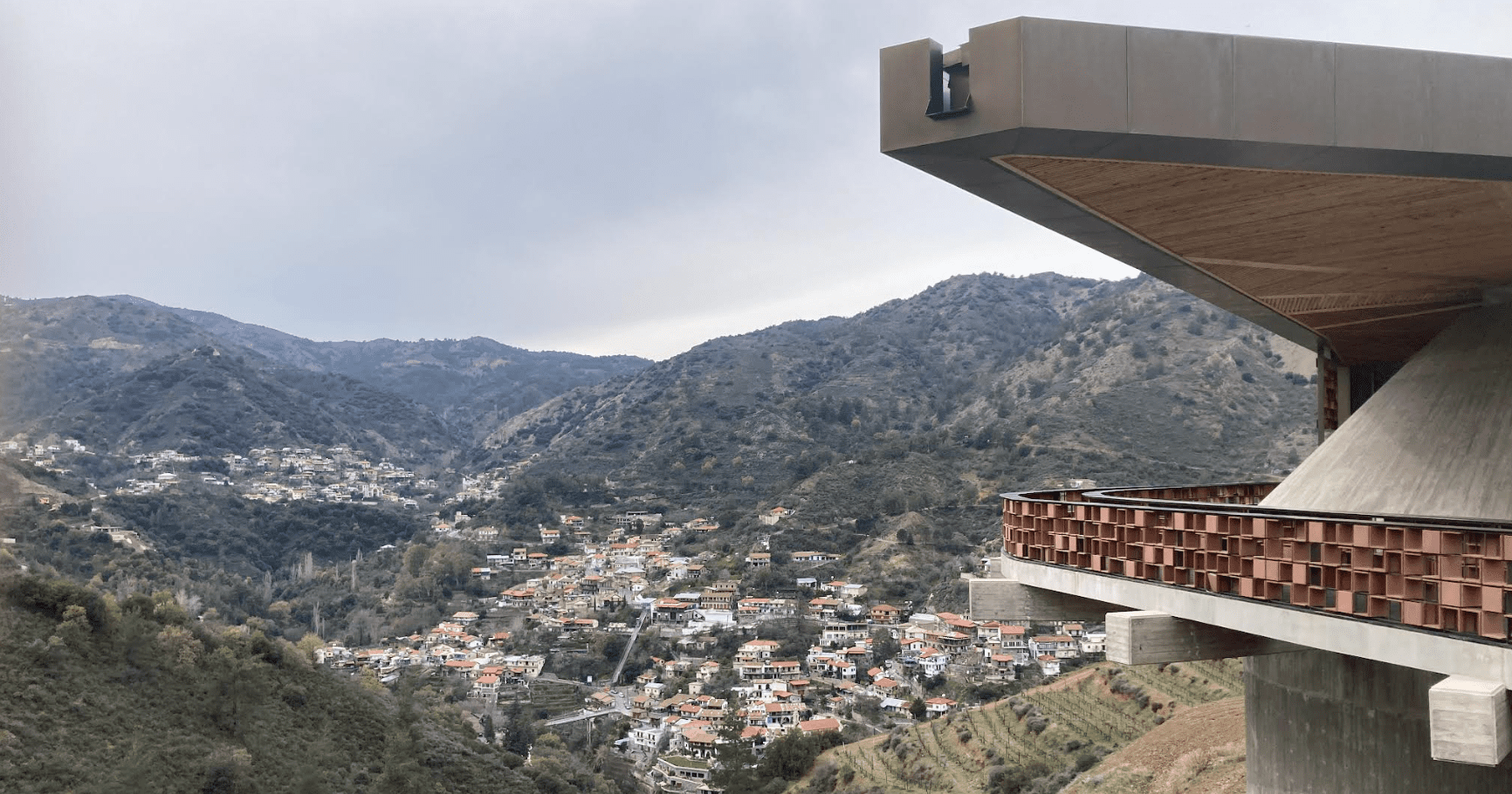
Christos Ioannou marvels at the Marathasa winery and takes us to lunch.
‘Last but not Least’ is a phrase often heard, and, in the case of the CWW trip to Cyprus, couldn’t be more appropriate for the visit to Marathasa Winery. The journey from Limassol to the winery in the village of Oikos at 1,125 m above sea level high in the Trodos mountains took 1 hour 40 minutes, passing spectacular scenery on the way. On arrival, jaws dropped and eyes widened at the sight of the extraordinary structure in front of us. The winery is the newest in Cyprus, and was officially opened on 17th June last year.
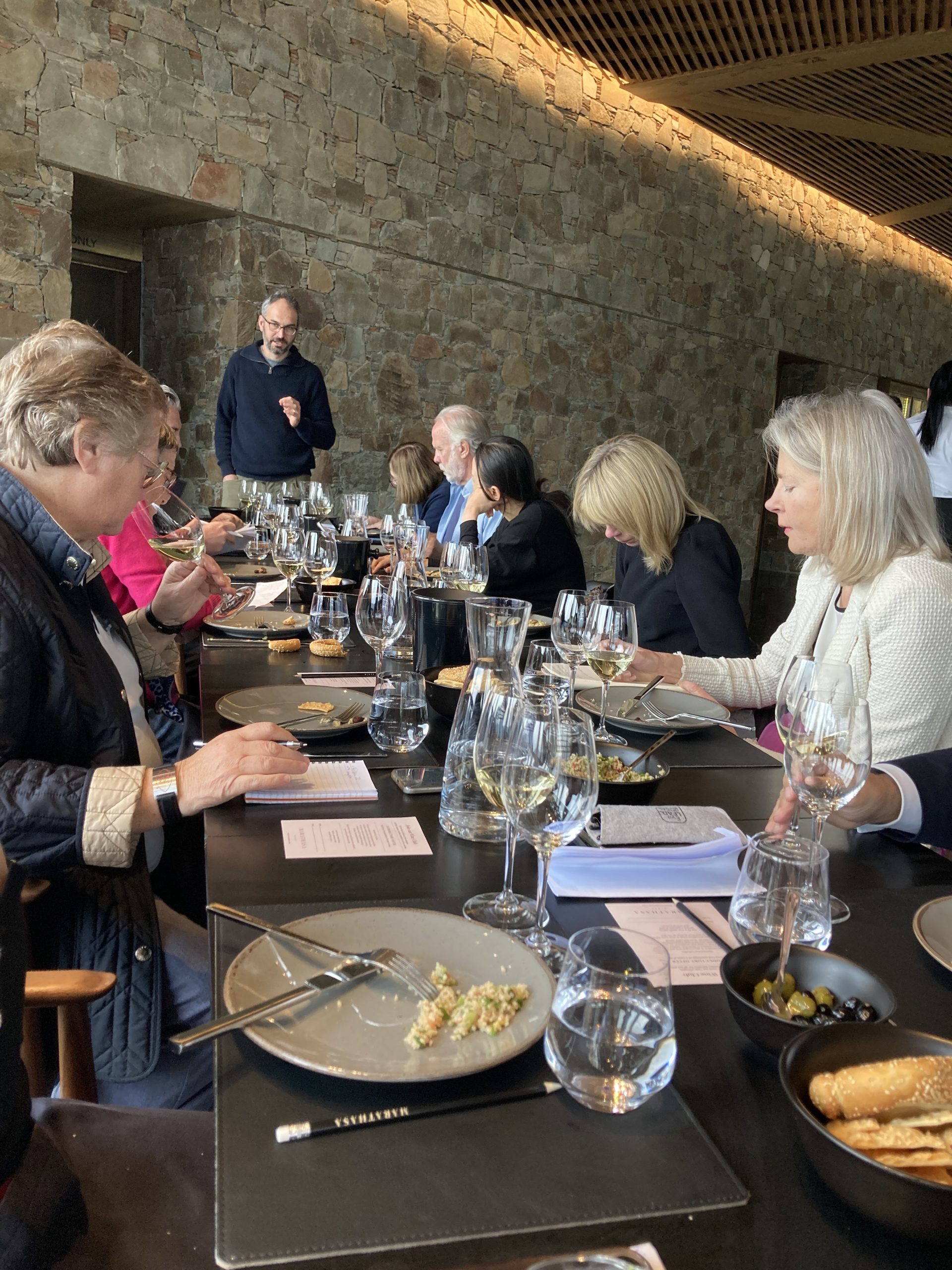 The winery is the vision of John Papdouris, whose main business is, fittingly, construction. Wine was in John’s blood as his grandfather was a wine merchant, and as a child he helped to crush grapes. The Papadouris family hail from Kalopanayiotis, which is overlooked by the winery, and John has done much to revitalise the village, breathing life into the remote community. He has even built a luxury hotel resort and spa retreat, Casale Panayiotis.
The winery is the vision of John Papdouris, whose main business is, fittingly, construction. Wine was in John’s blood as his grandfather was a wine merchant, and as a child he helped to crush grapes. The Papadouris family hail from Kalopanayiotis, which is overlooked by the winery, and John has done much to revitalise the village, breathing life into the remote community. He has even built a luxury hotel resort and spa retreat, Casale Panayiotis.
The project involved replanting abandoned vineyards and planting new ones. The ‘vineyard area’ is 2 square kilometres and includes a small forest. But only 40-60% of the land can be planted to vines as ALL the vineyards are hewn out of steep terraces, so there are actually 13 hectares of vines. The altitude is of course used to temper Cyprus’ scorching hot summers, but in addition, vines are planted on north-facing slopes.
All of the vineyards are within 10 minutes driving distance of the winery, so grapes arrive at the winery very shortly after picking. After chilling overnight, they are double sorted – manually on a sorting table and then mechanically by roller. A Bucher press is used for whites and rosés. The design of the winery into three sections (fermentation, ageing and storage), with high-ceilinged structures topped by latticed wooden roofs, was inspired by the local monastery with three domes.
The winemaker Viktor Finopoulos, who has worked harvests in Alentejo, Chablis and Marlborough, told us that there are three main geological formations in the region – Gavro (whitestone), which is rich in magnesium and iron; Plagio granite; and Diabase. The main soil type is volcanic. Incidentally, as the region has had incredibly low rainfall in the last three years – 26mm each year – it could be considered a desert viticulturally.
Viktor took us through an interesting tasting of local, Greek and ‘international’ varietals – Xynisteri, Sauvignon Blanc, Moschofilero, Assyrtiko, Yanoudi (for me the standout wine) and Syrah.
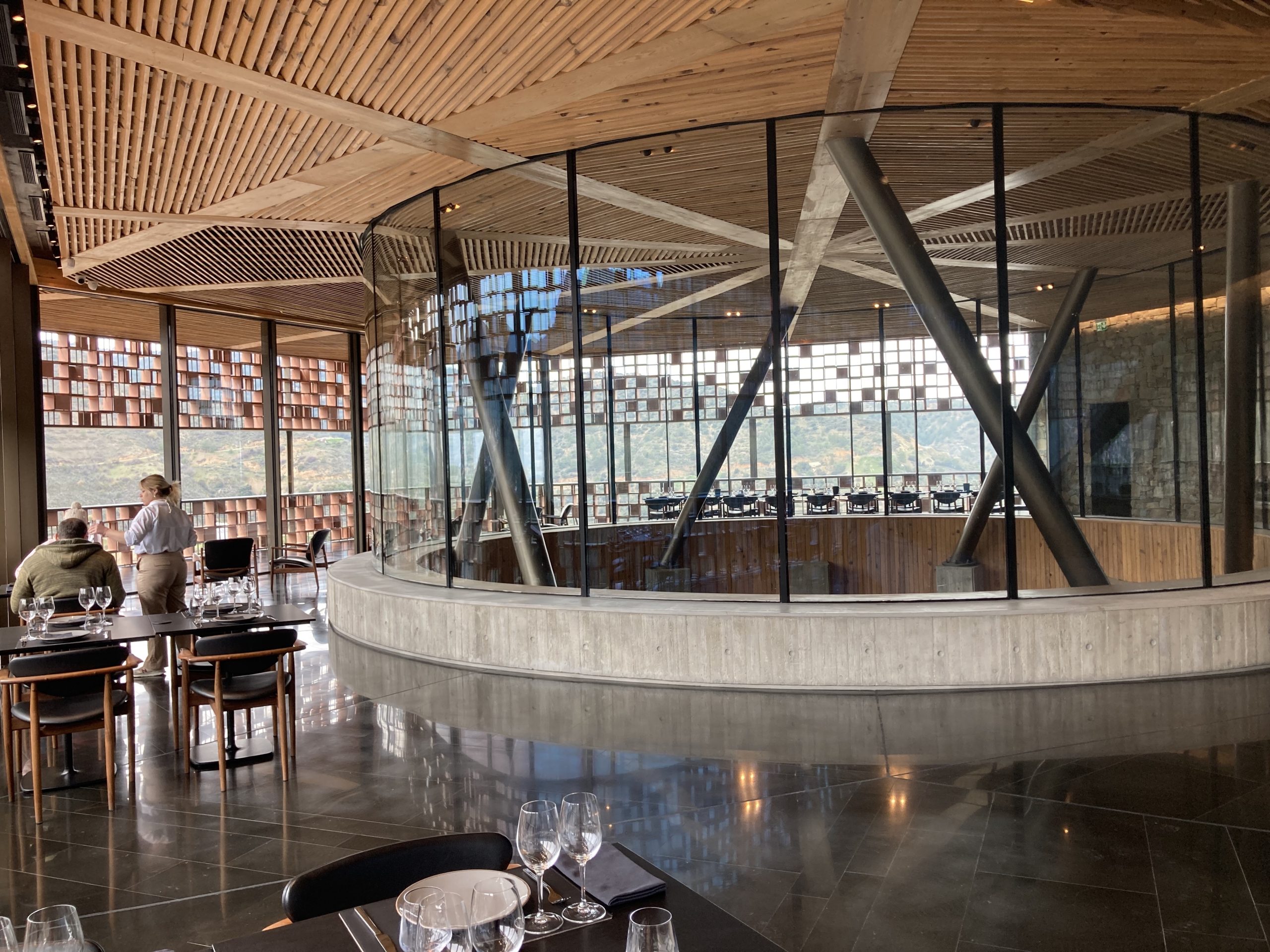

As for lunch, after several days of ‘traditional’ mezes served in vast quantities, we enjoyed some delicious dishes of beautifully cooked and presented food, which wouldn’t be out of place in a fancy winery restaurant in California:
- Spinach and feta phyllo cigars
- Blue-cheese aioli, hiromeri and baby rocket phyllo tartlets
- Sesame-crumbed chicken strips with herb aioli
- Mini lamb-burgers with beetroot marmalade in brioche
- Dukkah-crusted pork-kebabs with mustard dip
Marathasa is an exciting, country-leading project which is guaranteed to deliver wonderful wines as well as legendary Cypriot hospitality.
…
Markus Hungerbühler closes the coverage with commentary on Commandaria, ‘The Wine of Kings’.
Close to the village of Oikos, north of the Troodos Mountains, we gathered in the conference room of the impressive Marathasa Winery, with its futuristic architecture. There we met George Kassianos, President of the Cyprus Sommeliers Association, and Thoukis Georgiou, and his colleague Maria, of the Viticulture and Oenology Section in the Ministry of Agriculture. The topic of Thoukis’ and Maria’s highly informative talk was the history and the future of ‘The Wine of Kings’ Commandaria (Κουμανδαρία). Commandaria is one of the seven Protected Designations of Origin (PDO) on the island. It was the first to be defined on Cyprus (in 1980) but is deemed to be the oldest designation of origin in the world.
The wine is named after the ‘Grand Commandarie’, the headquarter castle of the Knights of the Order of Saint John of Jerusalem, who settled in Erimi, close to Limassol. The wine has always been related to Christianity since it was used during mass and it was the Christian order who produced it, making it an ecclesiastical wine. This of course can limit its appeal, and that is why the Ministry of Agriculture is trying to develop Commandaria into a lifestyle wine. It is with this aim in mind that George Kassianos enthused about enjoying Commandaria on crushed ice as aperitif.
Today, the PDO encompasses 14 villages on the southern slopes of the Troodos Mountains, of which 425.5 ha are under vine. The soils in the west of the delimited area are calcareous (limestone) e.g. in Kapilio, while in the east there are volcanic soils e.g. in Zoopigi, the village known as the Capital of Commandaria. The vineyards are at altitudes of between 400 m to 900 m, and no irrigation is allowed. The vines must be grown as bush vines, and the only permitted varieties are Xynisteri and Mavro.
Thoukis informs us that there are in fact two wine product categories for the Commandaria PDO: Commandaria as ‘liqueur wine’ with an actual alcoholic strength of 14.5% and 180 g/l sugar on average and ‘wine from raisined grapes’ with an actual alcoholic strength of 12% and 220 g/l sugar on average. According to Thoukis, this situation may confuse consumers but he also sees that ‘wine from raisined grapes’ is a more neutral description. He tells us that Commandaria is still produced in the same way as the ancient Greek poet Hesiod described it: “They would leave the grapes under the sun for ten days and ten nights, and in the shade for five days and for eight days in containers”.
After fermentation the wine has to be aged for at least two years in oak barrels, and of course, quality producers age it for much longer. Fortification is not mandatory and was only introduced during the British rule of Cyprus, when the British wanted to keep the wine stable for shipping it to their troops in India. Modern producers like Zambartas, Tsiakkas and Kyperounda do not fortify their Commandaria, which results in delicate, well balanced and highly drinkable wines. With its great history and elaborate production method, Commandaria is of course Cyprus’ flagship-wine, worth to be enjoyed also outside Cyprus.

